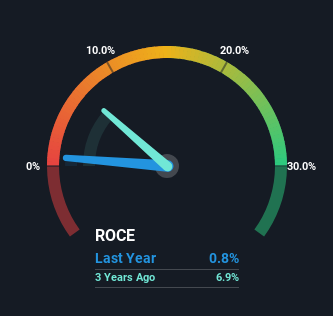- South Korea
- /
- Construction
- /
- KOSE:A006360
There Are Reasons To Feel Uneasy About GS Engineering & Construction's (KRX:006360) Returns On Capital
What trends should we look for it we want to identify stocks that can multiply in value over the long term? Firstly, we'll want to see a proven return on capital employed (ROCE) that is increasing, and secondly, an expanding base of capital employed. This shows us that it's a compounding machine, able to continually reinvest its earnings back into the business and generate higher returns. In light of that, when we looked at GS Engineering & Construction (KRX:006360) and its ROCE trend, we weren't exactly thrilled.
Return On Capital Employed (ROCE): What Is It?
Just to clarify if you're unsure, ROCE is a metric for evaluating how much pre-tax income (in percentage terms) a company earns on the capital invested in its business. The formula for this calculation on GS Engineering & Construction is:
Return on Capital Employed = Earnings Before Interest and Tax (EBIT) ÷ (Total Assets - Current Liabilities)
0.0076 = ₩68b ÷ (₩17t - ₩8.4t) (Based on the trailing twelve months to September 2024).
Therefore, GS Engineering & Construction has an ROCE of 0.8%. In absolute terms, that's a low return and it also under-performs the Construction industry average of 6.6%.
View our latest analysis for GS Engineering & Construction

Above you can see how the current ROCE for GS Engineering & Construction compares to its prior returns on capital, but there's only so much you can tell from the past. If you'd like, you can check out the forecasts from the analysts covering GS Engineering & Construction for free.
The Trend Of ROCE
In terms of GS Engineering & Construction's historical ROCE movements, the trend isn't fantastic. Around five years ago the returns on capital were 10%, but since then they've fallen to 0.8%. On the other hand, the company has been employing more capital without a corresponding improvement in sales in the last year, which could suggest these investments are longer term plays. It's worth keeping an eye on the company's earnings from here on to see if these investments do end up contributing to the bottom line.
On a side note, GS Engineering & Construction's current liabilities are still rather high at 49% of total assets. This can bring about some risks because the company is basically operating with a rather large reliance on its suppliers or other sorts of short-term creditors. Ideally we'd like to see this reduce as that would mean fewer obligations bearing risks.
What We Can Learn From GS Engineering & Construction's ROCE
Bringing it all together, while we're somewhat encouraged by GS Engineering & Construction's reinvestment in its own business, we're aware that returns are shrinking. And in the last five years, the stock has given away 22% so the market doesn't look too hopeful on these trends strengthening any time soon. All in all, the inherent trends aren't typical of multi-baggers, so if that's what you're after, we think you might have more luck elsewhere.
One more thing, we've spotted 2 warning signs facing GS Engineering & Construction that you might find interesting.
While GS Engineering & Construction may not currently earn the highest returns, we've compiled a list of companies that currently earn more than 25% return on equity. Check out this free list here.
New: Manage All Your Stock Portfolios in One Place
We've created the ultimate portfolio companion for stock investors, and it's free.
• Connect an unlimited number of Portfolios and see your total in one currency
• Be alerted to new Warning Signs or Risks via email or mobile
• Track the Fair Value of your stocks
Have feedback on this article? Concerned about the content? Get in touch with us directly. Alternatively, email editorial-team (at) simplywallst.com.
This article by Simply Wall St is general in nature. We provide commentary based on historical data and analyst forecasts only using an unbiased methodology and our articles are not intended to be financial advice. It does not constitute a recommendation to buy or sell any stock, and does not take account of your objectives, or your financial situation. We aim to bring you long-term focused analysis driven by fundamental data. Note that our analysis may not factor in the latest price-sensitive company announcements or qualitative material. Simply Wall St has no position in any stocks mentioned.
About KOSE:A006360
GS Engineering & Construction
Engages in the civil works and construction, sales of new houses, repairs and maintenance, overseas general construction, and technology consultation activities in South Korea and internationally.
Fair value with moderate growth potential.
Similar Companies
Market Insights
Community Narratives




